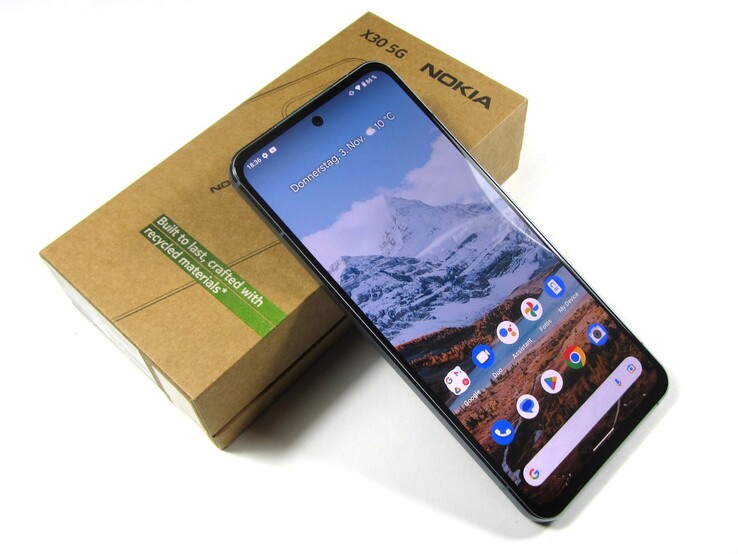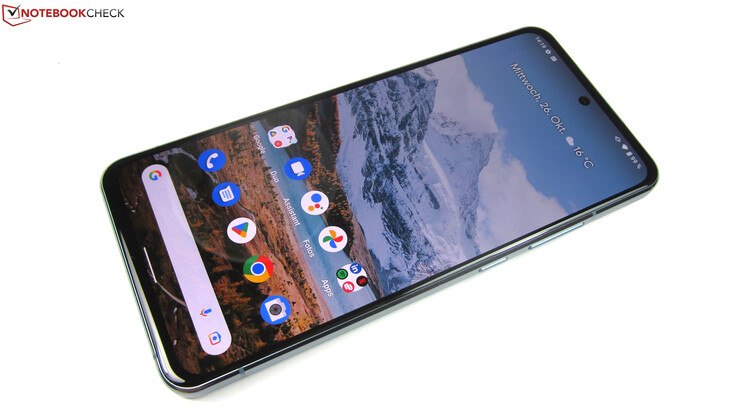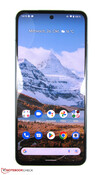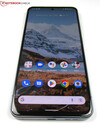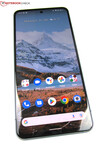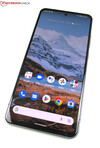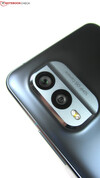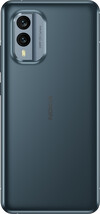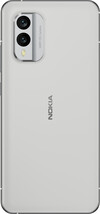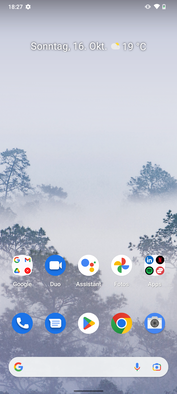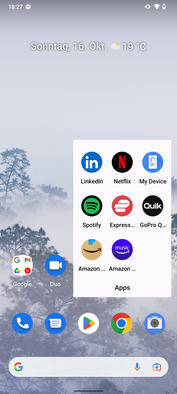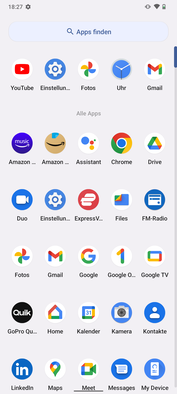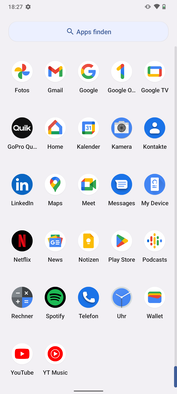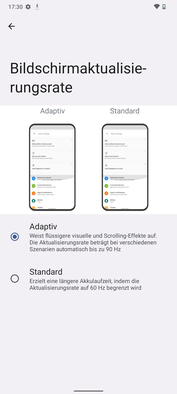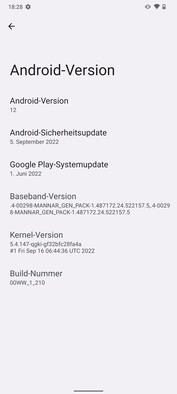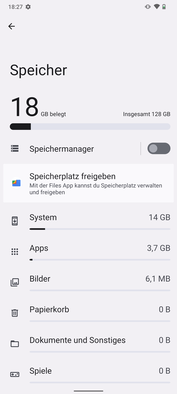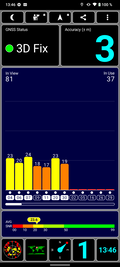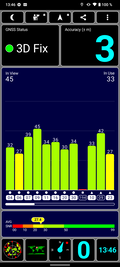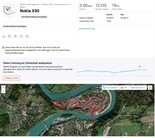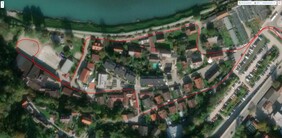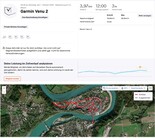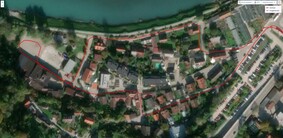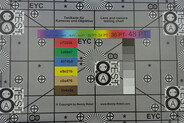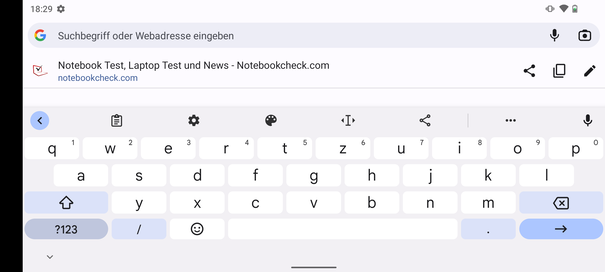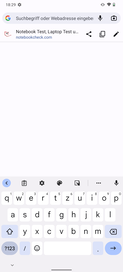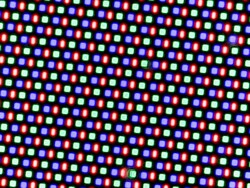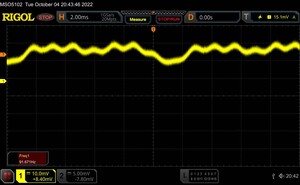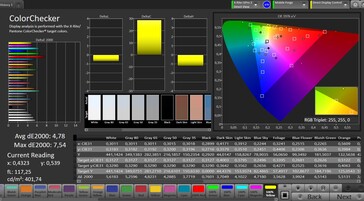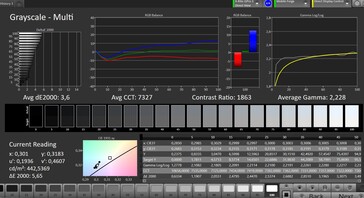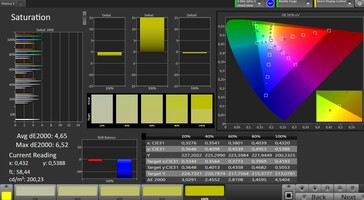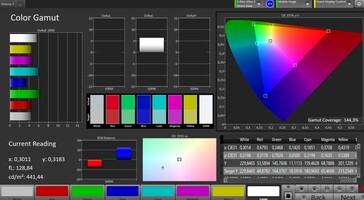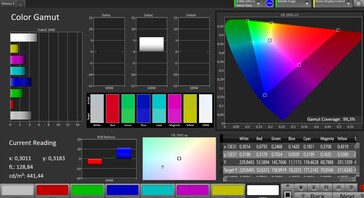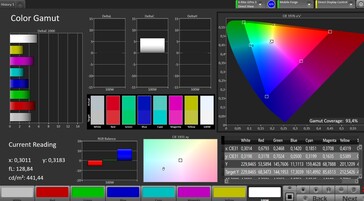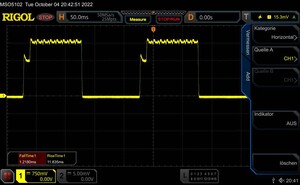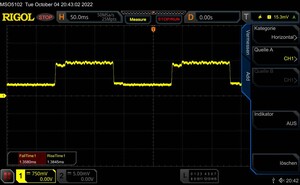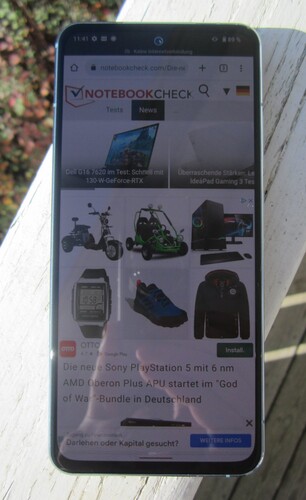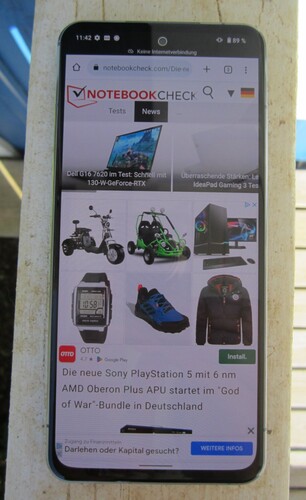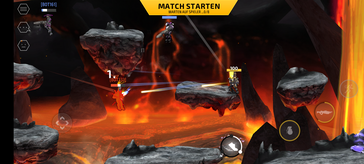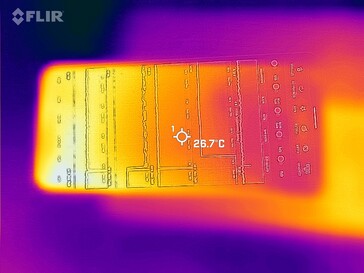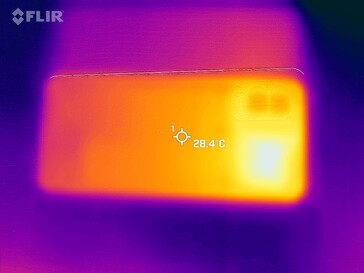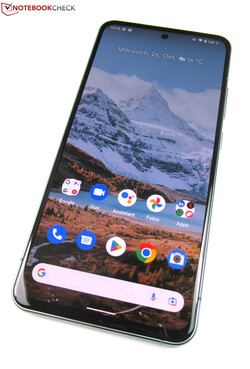Nokia X30 smartphone review: Nokia's fastest eco-smartphone
With the X30 5G, Nokia is introducing what it claims to be its most sustainable smartphone to date. The frame of the 6.43-inch Android phone is made from recycled aluminum, while the back cover is made from 65 percent recycled plastic. Nokia produces the packaging of the X30 5G from 70 percent recycled paper and omits the charger to minimize e-waste and emissions.
In keeping with the eco-friendly focus, you can also rent the smartphone instead of buying it, thus counteracting the throwaway mentality.
A Snapdragon 695 5G powers Nokia's mid-range smartphone, flanked by up to 8 GB of RAM and 256 GB of storage. In contrast to its IPS predecessor, the Nokia X20, the X30 5G has a 90 Hz AMOLED display and comes with Android 12 out of the box. This is further accompanied by a 3-year warranty and the manufacturer's promise to provide the X30 5G with Android upgrades and security updates for just as long.
Possible Competitors in Comparison
Rating | Date | Model | Weight | Drive | Size | Resolution | Price |
|---|---|---|---|---|---|---|---|
| 81.7 % v7 (old) | 11 / 2022 | Nokia X30 SD 695 5G, Adreno 619 | 185 g | 128 GB UFS 2.2 Flash | 6.43" | 2400x1080 | |
| 85.8 % v7 (old) | 09 / 2022 | Google Pixel 6a Tensor, Mali-G78 MP20 | 178 g | 128 GB UFS 3.1 Flash | 6.10" | 2400x1080 | |
| 80.6 % v7 (old) | 05 / 2021 | Nokia X20 SD 480, Adreno 619 | 220 g | 128 GB UFS 2.1 Flash | 6.67" | 2400x1080 | |
| 85.6 % v7 (old) | 07 / 2022 | Nothing Phone (1) SD 778G+ 5G, Adreno 642L | 193.5 g | 256 GB UFS 3.1 Flash | 6.55" | 2400x1080 | |
| 83.4 % v7 (old) | 06 / 2022 | Samsung Galaxy A53 Exynos 1280, Mali-G68 MP4 | 189 g | 128 GB UFS 2.1 Flash | 6.50" | 2400x1080 | |
| 87.7 % v7 (old) | 03 / 2022 | Xiaomi 12 SD 8 Gen 1, Adreno 730 | 179 g | 256 GB UFS 3.1 Flash | 6.28" | 2400x1080 |
Case - Lighter and more elegant than the predecessor
Nokia offers the X30 5G in the colors "Cloudy Blue" and "Ice White", whereby the former looks more like a dark gray or green depending on the ambient light. At 185 grams, the smartphone is significantly lighter than its Nokia X20 predecessor, which weighs 220 grams with its 6.67-inch display. The review candidate goes one step further with its IP67 certification and is thus dust- and waterproof.
While the back cover of Nokia's X30 5G is made of plastic, it feels much higher-quality and fits well with the aluminum frame that stably holds the front and back together. Thanks to its matte surface, the back of the X30 5G is very fingerprint resistant and merges seamlessly with the camera unit, which protrudes around 3 millimeters from the back cover.
The AMOLED display is protected by Gorilla Glass Victus and houses a fingerprint sensor hidden underneath the screen. The 16 MP selfie camera sits in a punchhole in the center at the top.
Equipment - Renting the Nokia X30 instead of buying
The Nokia X30 5G comes in two storage variants. The first variant, with 6 GB RAM and 128 GB of storage, officially costs EUR 519 (~US$ 514). The second variant may be more interesting, offering 8 GB RAM and 256 GB storage, but only costing EUR 30 (~US$ 29) more at EUR 549 (~US$ 545).
Instead of buying the smartphone, you can also rent it. This is possible via Nokia's subscription model, which is offered at EUR 25 (~US$ 24) per month and can be canceled with a 3-month period of notice. Once the X30 5G is returned, it is given to another subscriber in line with Nokia's sustainability standards. According to the manufacturer, older smartphones are either recycled or donated to charity. If no longer functioning, the smartphones can also be used for spare parts.
Unlike its Nokia X20 predecessor, the X30 5G does not have a headphone jack and a microSD slot. Instead, an OTG-capable USB-C port that transfers data at USB 2.0 speeds, an FM radio receiver, Bluetooth 5.1 and an NFC chip are included. The smartphone also plays HD web streams thanks to DRM Widevine L1 support.
Software - Three Android upgrades guaranteed
The X30 5G runs a stock Android 12, which Nokia has supplemented with only a handful of third-party apps such as LinkedIn, Netflix, GoPro Quik and Spotify. The tools are located in the Apps folder on the home screen and can all be uninstalled if desired. Nokia's in-house support app My Device also counts among the smartphone's software repertoire.
Nokia also intends to supply the X30 5G with monthly security updates for three years and also promises three operating system upgrades. We can thus reasonably assume that Android 15 will also be provided for the smartphone.
However, the manufacturer appears to be lax in regard to monthly security updates, at least during our review period. As of early November, the Android security patch was from September 5, at least a month too long when judging Nokia by its own standards.
Communication and GNSS - WiFi 6 speed only on paper
At 16 4G bands and 11 5G bands, the Nokia X30 5G offers rather broad mobile frequency coverage. Although a little too sparse for international use, no connection problems should be expected in the European area.
With WiFi 6 (aka WLAN 802.11ax), Nokia's X30 5G is equipped with a fast WLAN standard. Wi-Fi transfer rates prove stable under testing, but are on the Wi-Fi 5 level at best.
At a peak rate of 359 Mbps, the X30 5G is slightly faster than the WiFi-5 capable Nokia X20, but falls far behind comparison devices such as the Google Pixel 6a and the Xiaomi 12, which achieve more than double the data throughput.
| Networking | |
| iperf3 receive AXE11000 | |
| Google Pixel 6a | |
| Xiaomi 12 | |
| Average of class Smartphone (52 - 1857, n=180, last 2 years) | |
| Samsung Galaxy A53 | |
| Nokia X30 | |
| iperf3 transmit AXE11000 | |
| Google Pixel 6a | |
| Xiaomi 12 | |
| Average of class Smartphone (49.8 - 1828, n=180, last 2 years) | |
| Nokia X30 | |
| Samsung Galaxy A53 | |
| iperf3 transmit AXE11000 6GHz | |
| Xiaomi 12 | |
| Average of class Smartphone (508 - 1945, n=90, last 2 years) | |
| Nothing Phone (1) | |
| iperf3 receive AXE11000 6GHz | |
| Xiaomi 12 | |
| Average of class Smartphone (451 - 1870, n=90, last 2 years) | |
| Nothing Phone (1) | |
| iperf3 transmit AX12 | |
| Nokia X20 | |
| iperf3 receive AX12 | |
| Nokia X20 | |
Localization of the Nokia smartphone finds takes place via the satellite navigation systems GPS (L1, L5), Glonass (L1), Galileo (E1, E5a) and Beidou (B1, B2a, B1c). Under testing, this worked quickly inside buildings as well as outdoors with an accuracy of up to three meters.
The X30 5G also provided precise location data on a 4-kilometer bike ride. Compared to the Garmin Venu 2 fitness smartwatch, the smartphone is not quite as accurate, but the small deviations recorded are so minimal that they do not negatively impact everyday use.
Telephony and Voice Quality
The Nokia X30 5G delivers good voice quality during calls. Our voice reaches the other party clearly and distinctly. Ambient noise is reliably filtered out, even when hands-free mode is enabled. The only drawback: The body SAR radiation level is quite high (head SAR 0.79 W/kg).
VoLTE and WLAN calls are supported. Two nano-SIM cards fit in the SIM slot. An eSIM can also be activated.
Cameras - Dual camera with 50 MP
The dual camera system of the X30 5G consists of a 50 MP main camera and a 13 MP ultra-wide-angle camera. The former offers optical image stabilization and takes 12.5 MP photos using 4-in-1 pixel binning. The ultra-wide-angle camera (f/2.4) covers a 123° field of view.
Like the main camera, the 16 MP selfie camera, which is housed in a punchhole, combines four adjacent pixels into one. It takes good 4 MP shots and is able to produce bokeh effects in portrait mode with the help of AI. Other special image modes include a tripod mode for long exposures and night shots, and 'Dark Vision' mode for particularly dark environments.
The X30 5G is said to deliver "the best PureView photo experience to date," according to Nokia's own statements, implying that buyers can expect better image quality compared to the average mid-range smartphone. The main camera actually takes good pictures in daylight that impress with natural colors. But sometimes the contrast is a little low and the details not so rich. The night shots are more impressive because the main camera still manages to take sharp and vivid photos, even in very low residual light.
The ultra-wide-angle camera cannot compete with the main camera, but it makes use of its capabilities to achieve decent picture quality. The underlying feature is called 'Capture Fusion' and functions as follows: images from the main and ultra-wide-angle cameras are combined, which means that the ultra-wide-angle photo then has more details in the center of the image. This is directly noticeable in the test shots, for example, of the embankment and its shadows, which are sharper and more detailed than the photos of all comparison devices.
However, the weaknesses of the ultra-wide-angle camera are just as noticeable wherever the assistance of the main camera is lacking, such as in the peripheral areas, which appear blurry.
The X30 5G can record videos in Full HD at 60 FPS and is supported by software image stabilization. Overall, the picture quality is decent, but not outstanding. On the other hand, we really liked the sound, which is recorded very clearly. Higher resolutions than Full HD are not possible because the Snapdragon 695 5G does not support 4K videos.
Image comparison
Choose a scene and navigate within the first image. One click changes the position on touchscreens. One click on the zoomed-in image opens the original in a new window. The first image shows the scaled photograph of the test device.
Daylight photo 1Daylight photo 2Ultra wide angleLow light photoThe main camera once again demonstrates its talents under controlled lighting conditions. Under optimal light, it reproduces the colors of the ColorChecker reference chart very accurately (with the exception of the darker green and brown tones) and also displays the test chart sharply. However, color fidelity and, above all, image sharpness suffer under low light conditions (1 lux residual light).
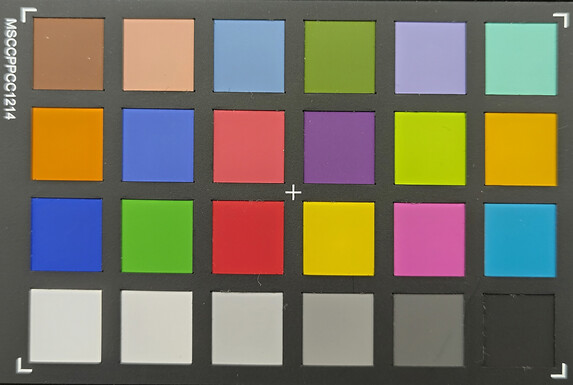
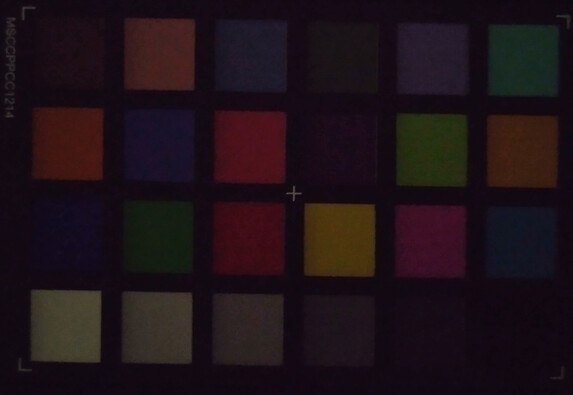
Accessories & Warranty - 3 years warranty for Nokia's smartphone
In addition to the smartphone, the X30 5G's flat packaging contains a USB cable (type A to C), a SIM tool, a quick start guide, and a brochure with safety instructions.
Nokia's online store offers numerous accessories such as speakers, headphones, protective covers and power adapters. Although the smartphone can be charged with up to 33 watts, only two 18-watt power adapters were available in Nokia's store at the time of review.
The Nokia X30 5G comes with a 36-month warranty in the EU region. According to Nokia's warranty conditions, Australia, the UK, Iceland, Liechtenstein, Montenegro, Northern Macedonia, Norway, Switzerland and Serbia also benefit from the 36-month warranty. This may differ in other countries, so interested buyers should check with their supplier before purchasing.
Input Devices & Operation - Responsive 90 Hz touchscreen
The Nokia X30 5G is pleasantly smooth to use thanks to its 90 Hz screen. Moreover, the touchscreen responds accurately to inputs right up to the corners and offers very little resistance to the fingers.
However, the Snapdragon 695 5G and 6 GB of RAM do not make the Nokia smartphone a racehorse. A few stutters in the otherwise smooth display can occur when a large number of apps are open at the same time or complex background processes are running.
The fingerprint sensor of the X30 5G is located under the screen and unlocks the smartphone quickly and reliably. The fingerprint icon is displayed by default even when the display is deactivated, so the screen does not have to be turned on for authentication.
If the Activate display when lifting option is selected in the system settings, 2D face recognition functions just as well. The hit rate of face scans was equal to that of the fingerprint sensor under testing, but requires sufficient ambient light or a bright display.
Display - AMOLED panel with four-digit brightness
The 6.43-inch AMOLED panel of the Nokia X30 5G has a resolution of 2400 x 1080 pixels (aspect ratio 20:9), corresponding to a decent pixel density of 409 PPI.
The refresh rate can be adjusted in two stages. In the preset Adaptive setting, the Nokia smartphone automatically adjusts the refresh rate to the content displayed, which works up to a maximum of 90 Hz. In the second stage, the standard setting, the refresh rate is limited to 60 Hz.
The AMOLED panel shines at an average of 708.7 cd/m² on a pure white background. If we restrict the luminance measurement to a smaller image section (APL18) instead of the full screen, we can even elicit a brightness of up to 1048 cd/m² from the display.
The AMOLED display regulates its brightness via pulse width modulation (PWM) and flickers at a low 92 Hz in all brightness levels we measured. Because the amplitude curve of the frequency curve is always very flat, the Nokia X30 5G should also be suitable for sensitive users. However, we could not find a DC dimming mode in the Android settings.
| |||||||||||||||||||||||||
Brightness Distribution: 83 %
Center on Battery: 693 cd/m²
Contrast: ∞:1 (Black: 0 cd/m²)
ΔE ColorChecker Calman: 4.78 | ∀{0.5-29.43 Ø4.79}
ΔE Greyscale Calman: 3.6 | ∀{0.09-98 Ø5}
144.3% sRGB (Calman 2D)
Gamma: 2.228
CCT: 7327 K
| Nokia X30 AMOLED, 2400x1080, 6.4" | Google Pixel 6a AMOLED, 2400x1080, 6.1" | Nokia X20 IPS, 2400x1080, 6.7" | Nothing Phone (1) OLED, 2400x1080, 6.6" | Samsung Galaxy A53 AMOLED, 2400x1080, 6.5" | Xiaomi 12 OLED, 2400x1080, 6.3" | |
|---|---|---|---|---|---|---|
| Screen | 39% | -20% | 32% | 29% | 37% | |
| Brightness middle (cd/m²) | 693 | 758 9% | 646 -7% | 620 -11% | 718 4% | 867 25% |
| Brightness (cd/m²) | 709 | 767 8% | 617 -13% | 625 -12% | 730 3% | 867 22% |
| Brightness Distribution (%) | 83 | 93 12% | 89 7% | 98 18% | 92 11% | 98 18% |
| Black Level * (cd/m²) | 0.7 | |||||
| Colorchecker dE 2000 * | 4.78 | 0.9 81% | 5.71 -19% | 1.24 74% | 1.62 66% | 1.7 64% |
| Colorchecker dE 2000 max. * | 7.54 | 2.5 67% | 8.9 -18% | 2.31 69% | 4.21 44% | 4.4 42% |
| Greyscale dE 2000 * | 3.6 | 1.6 56% | 6.2 -72% | 1.7 53% | 2 44% | 1.8 50% |
| Gamma | 2.228 99% | 2.2 100% | 2.122 104% | 2.318 95% | 2.156 102% | 2.2 100% |
| CCT | 7327 89% | 6599 98% | 8256 79% | 6325 103% | 6545 99% | 6762 96% |
| Contrast (:1) | 923 |
* ... smaller is better
Screen Flickering / PWM (Pulse-Width Modulation)
| Screen flickering / PWM detected | 92 Hz | ||
The display backlight flickers at 92 Hz (worst case, e.g., utilizing PWM) . The frequency of 92 Hz is very low, so the flickering may cause eyestrain and headaches after extended use. In comparison: 53 % of all tested devices do not use PWM to dim the display. If PWM was detected, an average of 8163 (minimum: 5 - maximum: 343500) Hz was measured. | |||
Series of measurements at a fixed zoom level and different brightness settings
In the test lab, the screen of the Nokia X30 5G does not prove to be particularly color accurate. The AMOLED panel clearly far from the ideal values in colors and grayscale (Delta-E > 3), and the high color temperature makes the display look cool. Not much can be done to improve picture quality, since the display settings only offer the choice of white balance and a design with a dark background.
Display Response Times
| ↔ Response Time Black to White | ||
|---|---|---|
| 13 ms ... rise ↗ and fall ↘ combined | ↗ 1 ms rise | |
| ↘ 12 ms fall | ||
| The screen shows good response rates in our tests, but may be too slow for competitive gamers. In comparison, all tested devices range from 0.1 (minimum) to 240 (maximum) ms. » 32 % of all devices are better. This means that the measured response time is better than the average of all tested devices (20.3 ms). | ||
| ↔ Response Time 50% Grey to 80% Grey | ||
| 2 ms ... rise ↗ and fall ↘ combined | ↗ 1 ms rise | |
| ↘ 1 ms fall | ||
| The screen shows very fast response rates in our tests and should be very well suited for fast-paced gaming. In comparison, all tested devices range from 0.165 (minimum) to 636 (maximum) ms. » 8 % of all devices are better. This means that the measured response time is better than the average of all tested devices (31.7 ms). | ||
Performance - Nokia smartphone with Snapdragon 695 5G
The X30 5G is equipped with a solid mid-range SoC in the form of the Snapdragon 695 5G and its Adreno 619 graphics unit. The eight-core processor is supported by 6 GB of RAM and achieves performance values comparable to the Exynos 1280, which is used in the Samsung Galaxy A53, among others.
The Nokia X30 5G runs through our benchmark testing a little faster than its predecessor, the Nokia X20, but does not prove to be a supercomputer either. Nonetheless, the given performance is completely sufficient for everyday use. Then again, the performance comparison with other mid-range smartphones in a similar price range is not too flattering.
The Nokia X30 5G is far behind in the synthetic benchmarks and GPU tests; much faster smartphones such as the Google Pixel 6a or the Xiaomi 12 are available at similar prices. The Nokia cuts a better figure in the browser and memory tests, as the performance gap to the competition is much smaller overall.
| UL Procyon AI Inference for Android - Overall Score NNAPI | |
| Google Pixel 6a | |
| Nothing Phone (1) | |
| Average of class Smartphone (3769 - 81594, n=137, last 2 years) | |
| Nokia X30 | |
| Average Qualcomm Snapdragon 695 5G (5442 - 9348, n=15) | |
| Nokia X20 | |
| Samsung Galaxy A53 | |
| AImark - Score v2.x | |
| Xiaomi 12 | |
| Google Pixel 6a | |
| Nothing Phone (1) | |
| Average Qualcomm Snapdragon 695 5G (4924 - 5839, n=10) | |
| Nokia X30 | |
| Nokia X20 | |
| Samsung Galaxy A53 | |
GFXBench (DX / GLBenchmark) 2.7: T-Rex Onscreen | 1920x1080 T-Rex Offscreen
GFXBench 3.0: on screen Manhattan Onscreen OGL | 1920x1080 1080p Manhattan Offscreen
GFXBench 3.1: on screen Manhattan ES 3.1 Onscreen | 1920x1080 Manhattan ES 3.1 Offscreen
GFXBench: on screen Car Chase Onscreen | 1920x1080 Car Chase Offscreen | on screen Aztec Ruins High Tier Onscreen | 2560x1440 Aztec Ruins High Tier Offscreen | on screen Aztec Ruins Normal Tier Onscreen | 1920x1080 Aztec Ruins Normal Tier Offscreen
| 3DMark / Wild Life Extreme Unlimited | |
| Xiaomi 12 | |
| Google Pixel 6a | |
| Nothing Phone (1) | |
| Samsung Galaxy A53 | |
| Nokia X30 | |
| 3DMark / Wild Life Extreme | |
| Xiaomi 12 | |
| Google Pixel 6a | |
| Nothing Phone (1) | |
| Samsung Galaxy A53 | |
| Nokia X30 | |
| 3DMark / Wild Life Unlimited Score | |
| Xiaomi 12 | |
| Google Pixel 6a | |
| Nothing Phone (1) | |
| Samsung Galaxy A53 | |
| Nokia X30 | |
| Nokia X20 | |
| 3DMark / Wild Life Score | |
| Xiaomi 12 | |
| Google Pixel 6a | |
| Nothing Phone (1) | |
| Samsung Galaxy A53 | |
| Nokia X30 | |
| Nokia X20 | |
| 3DMark / Sling Shot Extreme (Vulkan) Unlimited Physics | |
| Nothing Phone (1) | |
| Nokia X30 | |
| Samsung Galaxy A53 | |
| Nokia X20 | |
| Xiaomi 12 | |
| Google Pixel 6a | |
| 3DMark / Sling Shot Extreme (Vulkan) Unlimited Graphics | |
| Nothing Phone (1) | |
| Samsung Galaxy A53 | |
| Nokia X30 | |
| Nokia X20 | |
| Xiaomi 12 | |
| Google Pixel 6a | |
| 3DMark / Sling Shot Extreme (Vulkan) Unlimited | |
| Nothing Phone (1) | |
| Samsung Galaxy A53 | |
| Nokia X30 | |
| Nokia X20 | |
| Xiaomi 12 | |
| Google Pixel 6a | |
| 3DMark / Sling Shot Extreme (ES 3.1) Unlimited Physics | |
| Nothing Phone (1) | |
| Xiaomi 12 | |
| Google Pixel 6a | |
| Nokia X30 | |
| Samsung Galaxy A53 | |
| Nokia X20 | |
| 3DMark / Sling Shot Extreme (ES 3.1) Unlimited Graphics | |
| Xiaomi 12 | |
| Google Pixel 6a | |
| Nothing Phone (1) | |
| Samsung Galaxy A53 | |
| Nokia X30 | |
| Nokia X20 | |
| 3DMark / Sling Shot Extreme (ES 3.1) Unlimited | |
| Xiaomi 12 | |
| Google Pixel 6a | |
| Nothing Phone (1) | |
| Samsung Galaxy A53 | |
| Nokia X30 | |
| Nokia X20 | |
| 3DMark / Sling Shot OpenGL ES 3.0 Physics | |
| Nokia X30 | |
| Nokia X20 | |
| Samsung Galaxy A53 | |
| Xiaomi 12 | |
| Google Pixel 6a | |
| 3DMark / Sling Shot OpenGL ES 3.0 Graphics | |
| Samsung Galaxy A53 | |
| Nokia X30 | |
| Nokia X20 | |
| Xiaomi 12 | |
| Google Pixel 6a | |
| 3DMark / Sling Shot OpenGL ES 3.0 | |
| Nokia X30 | |
| Samsung Galaxy A53 | |
| Nokia X20 | |
| Xiaomi 12 | |
| Google Pixel 6a | |
| 3DMark / Sling Shot Extreme (ES 3.1) | |
| Nothing Phone (1) | |
| Samsung Galaxy A53 | |
| Nokia X30 | |
| Nokia X20 | |
| Xiaomi 12 | |
| Google Pixel 6a | |
| 3DMark / Sling Shot Extreme (ES 3.1) Graphics | |
| Nothing Phone (1) | |
| Samsung Galaxy A53 | |
| Nokia X30 | |
| Nokia X20 | |
| Xiaomi 12 | |
| Google Pixel 6a | |
| 3DMark / Sling Shot Extreme (ES 3.1) Physics | |
| Nothing Phone (1) | |
| Nokia X30 | |
| Nokia X20 | |
| Samsung Galaxy A53 | |
| Xiaomi 12 | |
| Google Pixel 6a | |
| 3DMark / Sling Shot OpenGL ES 3.0 Unlimited | |
| Xiaomi 12 | |
| Google Pixel 6a | |
| Samsung Galaxy A53 | |
| Nokia X30 | |
| Nokia X20 | |
| 3DMark / Sling Shot OpenGL ES 3.0 Unlimited Graphics | |
| Xiaomi 12 | |
| Google Pixel 6a | |
| Samsung Galaxy A53 | |
| Nokia X30 | |
| Nokia X20 | |
| 3DMark / Sling Shot OpenGL ES 3.0 Unlimited Physics | |
| Google Pixel 6a | |
| Xiaomi 12 | |
| Nokia X30 | |
| Nokia X20 | |
| Samsung Galaxy A53 | |
| GFXBench (DX / GLBenchmark) 2.7 / T-Rex Onscreen | |
| Xiaomi 12 | |
| Nothing Phone (1) | |
| Samsung Galaxy A53 | |
| Nokia X30 | |
| Google Pixel 6a | |
| Nokia X20 | |
| GFXBench (DX / GLBenchmark) 2.7 / T-Rex Offscreen | |
| Xiaomi 12 | |
| Google Pixel 6a | |
| Nothing Phone (1) | |
| Nokia X30 | |
| Samsung Galaxy A53 | |
| Nokia X20 | |
| GFXBench 3.0 / Manhattan Onscreen OGL | |
| Xiaomi 12 | |
| Nothing Phone (1) | |
| Google Pixel 6a | |
| Samsung Galaxy A53 | |
| Nokia X30 | |
| Nokia X20 | |
| GFXBench 3.0 / 1080p Manhattan Offscreen | |
| Xiaomi 12 | |
| Google Pixel 6a | |
| Nothing Phone (1) | |
| Samsung Galaxy A53 | |
| Nokia X30 | |
| Nokia X20 | |
| GFXBench 3.1 / Manhattan ES 3.1 Onscreen | |
| Xiaomi 12 | |
| Google Pixel 6a | |
| Nothing Phone (1) | |
| Samsung Galaxy A53 | |
| Nokia X30 | |
| Nokia X20 | |
| GFXBench 3.1 / Manhattan ES 3.1 Offscreen | |
| Xiaomi 12 | |
| Google Pixel 6a | |
| Nothing Phone (1) | |
| Samsung Galaxy A53 | |
| Nokia X30 | |
| Nokia X20 | |
| GFXBench / Car Chase Onscreen | |
| Xiaomi 12 | |
| Google Pixel 6a | |
| Nothing Phone (1) | |
| Samsung Galaxy A53 | |
| Nokia X30 | |
| Nokia X20 | |
| GFXBench / Car Chase Offscreen | |
| Xiaomi 12 | |
| Google Pixel 6a | |
| Nothing Phone (1) | |
| Samsung Galaxy A53 | |
| Nokia X30 | |
| Nokia X20 | |
| GFXBench / Aztec Ruins High Tier Onscreen | |
| Xiaomi 12 | |
| Google Pixel 6a | |
| Nothing Phone (1) | |
| Samsung Galaxy A53 | |
| Nokia X30 | |
| Nokia X20 | |
| GFXBench / Aztec Ruins High Tier Offscreen | |
| Xiaomi 12 | |
| Google Pixel 6a | |
| Nothing Phone (1) | |
| Samsung Galaxy A53 | |
| Nokia X30 | |
| Nokia X20 | |
| GFXBench / Aztec Ruins Normal Tier Onscreen | |
| Xiaomi 12 | |
| Google Pixel 6a | |
| Nothing Phone (1) | |
| Samsung Galaxy A53 | |
| Nokia X30 | |
| Nokia X20 | |
| GFXBench / Aztec Ruins Normal Tier Offscreen | |
| Xiaomi 12 | |
| Google Pixel 6a | |
| Nothing Phone (1) | |
| Samsung Galaxy A53 | |
| Nokia X30 | |
| Nokia X20 | |
| Jetstream 2 - 2.0 Total Score | |
| Average of class Smartphone (23.8 - 387, n=154, last 2 years) | |
| Xiaomi 12 (Chrome 99.0.4844.58) | |
| Google Pixel 6a (Firefox 1ß4-2-ß) | |
| Nothing Phone (1) (Chrome 103) | |
| Average Qualcomm Snapdragon 695 5G (48.6 - 105.3, n=19) | |
| Samsung Galaxy A53 (Chrome 101) | |
| Nokia X30 (Chrome 106.0.5249.118) | |
| Nokia X20 (Chrome 90) | |
| Speedometer 2.0 - Result 2.0 | |
| Average of class Smartphone (15.2 - 643, n=131, last 2 years) | |
| Xiaomi 12 (Chrome 99.0.4844.58) | |
| Google Pixel 6a (Chrome 105.0.5195.79) | |
| Average Qualcomm Snapdragon 695 5G (38.7 - 80.1, n=16) | |
| Nothing Phone (1) (Chome 103) | |
| Samsung Galaxy A53 (Chome 101) | |
| Nokia X30 (Chrome 106.0.5249.118) | |
| Nokia X20 (Chome 90) | |
| WebXPRT 4 - Overall | |
| Average of class Smartphone (27 - 306, n=147, last 2 years) | |
| Average Qualcomm Snapdragon 695 5G (58 - 111, n=18) | |
| Google Pixel 6a (Chrome 105.0.5195.79) | |
| Nothing Phone (1) (Chrome 103) | |
| Nokia X30 (Chrome 106.0.5249.118) | |
| WebXPRT 3 - Overall | |
| Average of class Smartphone (38 - 380, n=41, last 2 years) | |
| Xiaomi 12 (Chrome 99.0.4844.58) | |
| Nothing Phone (1) (Chrome 103) | |
| Average Qualcomm Snapdragon 695 5G (75 - 156, n=12) | |
| Google Pixel 6a (Chrome 105.0.5195.79) | |
| Nokia X30 (Chrome 106.0.5249.118) | |
| Nokia X20 (Chrome 90) | |
| Samsung Galaxy A53 (Chrome 101) | |
| Octane V2 - Total Score | |
| Average of class Smartphone (2228 - 121337, n=200, last 2 years) | |
| Xiaomi 12 (Chrome 99.0.4844.58) | |
| Google Pixel 6a (Chrome 105.0.5195.79) | |
| Nothing Phone (1) (Chrome 103) | |
| Samsung Galaxy A53 (Chrome 101) | |
| Average Qualcomm Snapdragon 695 5G (17849 - 31647, n=21) | |
| Nokia X30 (Chrome 106.0.5249.118) | |
| Nokia X20 (Chrome 90) | |
| Mozilla Kraken 1.1 - Total | |
| Nokia X20 (Chrome 90) | |
| Samsung Galaxy A53 (Chrome 101) | |
| Nokia X30 (Chrome 106.0.5249.118) | |
| Nothing Phone (1) (Chrome 103) | |
| Average Qualcomm Snapdragon 695 5G (1298 - 2501, n=18) | |
| Google Pixel 6a (Chrome 105.0.5195.79) | |
| Average of class Smartphone (257 - 28190, n=155, last 2 years) | |
| Xiaomi 12 (Chrome 99.0.4844.58) | |
* ... smaller is better
| Nokia X30 | Google Pixel 6a | Nokia X20 | Nothing Phone (1) | Samsung Galaxy A53 | Xiaomi 12 | Average 128 GB UFS 2.2 Flash | Average of class Smartphone | |
|---|---|---|---|---|---|---|---|---|
| AndroBench 3-5 | 68% | -7% | 121% | 14% | 178% | 20% | 199% | |
| Sequential Read 256KB (MB/s) | 499.88 | 1312.64 163% | 489.3 -2% | 1638 228% | 510.1 2% | 1851 270% | 736 ? 47% | 2216 ? 343% |
| Sequential Write 256KB (MB/s) | 467.96 | 712.94 52% | 462.7 -1% | 1351.9 189% | 486.7 4% | 1417 203% | 532 ? 14% | 1832 ? 291% |
| Random Read 4KB (MB/s) | 189.83 | 219.53 16% | 165.4 -13% | 240.6 27% | 229.9 21% | 325.2 71% | 193 ? 2% | 293 ? 54% |
| Random Write 4KB (MB/s) | 162.59 | 225.61 39% | 144.6 -11% | 228.2 40% | 210.8 30% | 437.5 169% | 186.3 ? 15% | 340 ? 109% |
Gaming - 90 FPS remain the big exception
Current games largely run smoothly on Nokia's X30 5G. Sometimes you have to reduce the graphics settings. In PUBG Mobile, the maximum setting that can be selected is "HD/High", which means that the game is almost always rendered at 30 FPS. In the case of the graphically undemanding Armajet, the Nokia smartphone is able to fully utilize its 90 Hz screen, but the frame rate is limited to 60 Hz, presumably for energy-saving reasons.
Frame rates are determined with our Gamebench testing tool.
Emissions - Always cool in operation
Temperature
The Nokia X30 5G stays pleasantly cool during use. It only heats up to a maximum of 38.5 °C, even under heavy load. Internally, the smartphone does not get out of control either. As shown in the 3DMark wild-life stress tests, it is able to extract full performance at virtually any time, even under prolonged maximum load.
(+) The maximum temperature on the upper side is 37.5 °C / 100 F, compared to the average of 35.2 °C / 95 F, ranging from 21.9 to 247 °C for the class Smartphone.
(+) The bottom heats up to a maximum of 34 °C / 93 F, compared to the average of 34 °C / 93 F
(+) In idle usage, the average temperature for the upper side is 22.7 °C / 73 F, compared to the device average of 32.9 °C / 91 F.
3DMark Wild Life Stress Test
| 3DMark | |
| Wild Life Stress Test Stability | |
| Nokia X30 | |
| Nokia X20 | |
| Samsung Galaxy A53 | |
| Nothing Phone (1) | |
| Xiaomi 12 | |
| Google Pixel 6a | |
| Wild Life Extreme Stress Test | |
| Nokia X30 | |
| Nothing Phone (1) | |
| Samsung Galaxy A53 | |
| Google Pixel 6a | |
| Xiaomi 12 | |
Speakers
The loudspeaker of the Nokia X30 5G, located next to the USB-C port, can play quite loudly at 82.3 dB(A) and produces a sound quality that is typical of smartphones, where trebles and mids dominate. Bass is virtually absent from the sound mix, which makes the sound quite thin overall.
Wired audio devices such as headphones can be connected to the smartphone via a USB-C adapter. This works wirelessly via Bluetooth 5.1. Bluetooth codecs ranging from aptX, aptX HD to aptX Adaptive are supported.
Nokia X30 audio analysis
(+) | speakers can play relatively loud (82.3 dB)
Bass 100 - 315 Hz
(-) | nearly no bass - on average 23.4% lower than median
(±) | linearity of bass is average (12.7% delta to prev. frequency)
Mids 400 - 2000 Hz
(±) | higher mids - on average 7.5% higher than median
(+) | mids are linear (5.7% delta to prev. frequency)
Highs 2 - 16 kHz
(+) | balanced highs - only 3.7% away from median
(±) | linearity of highs is average (8.6% delta to prev. frequency)
Overall 100 - 16.000 Hz
(±) | linearity of overall sound is average (22.5% difference to median)
Compared to same class
» 47% of all tested devices in this class were better, 6% similar, 47% worse
» The best had a delta of 12%, average was 35%, worst was 134%
Compared to all devices tested
» 65% of all tested devices were better, 6% similar, 29% worse
» The best had a delta of 4%, average was 24%, worst was 134%
Xiaomi 12 audio analysis
(+) | speakers can play relatively loud (90.7 dB)
Bass 100 - 315 Hz
(-) | nearly no bass - on average 19.3% lower than median
(±) | linearity of bass is average (8.2% delta to prev. frequency)
Mids 400 - 2000 Hz
(±) | higher mids - on average 5% higher than median
(+) | mids are linear (4.7% delta to prev. frequency)
Highs 2 - 16 kHz
(±) | higher highs - on average 7.5% higher than median
(+) | highs are linear (4.7% delta to prev. frequency)
Overall 100 - 16.000 Hz
(±) | linearity of overall sound is average (17.3% difference to median)
Compared to same class
» 11% of all tested devices in this class were better, 8% similar, 82% worse
» The best had a delta of 12%, average was 35%, worst was 134%
Compared to all devices tested
» 31% of all tested devices were better, 8% similar, 61% worse
» The best had a delta of 4%, average was 24%, worst was 134%
Battery Life - Enduring despite small battery
Power Consumption
Nokia equips the X30 5G with a 4200 mAh battery, which is relatively small by Android standards. Battery capacities between 4500 and 5000 mAh are usually common in competing devices. In return, Nokia's smartphone makes efficient use of its power storage and excels in energy-saving operation, especially under high load.
| Off / Standby | |
| Idle | |
| Load |
|
Key:
min: | |
| Nokia X30 4200 mAh | Google Pixel 6a 4410 mAh | Nothing Phone (1) 4500 mAh | Samsung Galaxy A53 5000 mAh | Xiaomi 12 4500 mAh | Average Qualcomm Snapdragon 695 5G | Average of class Smartphone | |
|---|---|---|---|---|---|---|---|
| Power Consumption | -7% | 0% | -7% | -9% | -2% | -26% | |
| Idle Minimum * (Watt) | 0.8 | 0.68 15% | 1 -25% | 0.9 -13% | 0.87 -9% | 0.886 ? -11% | 0.856 ? -7% |
| Idle Average * (Watt) | 1.5 | 1.56 -4% | 1.2 20% | 1.3 13% | 1.7 -13% | 1.76 ? -17% | 1.437 ? 4% |
| Idle Maximum * (Watt) | 1.8 | 1.58 12% | 1.5 17% | 1.6 11% | 1.82 -1% | 1.92 ? -7% | 1.612 ? 10% |
| Load Average * (Watt) | 4.3 | 5.37 -25% | 4.2 2% | 5.7 -33% | 4.68 -9% | 3.86 ? 10% | 7.1 ? -65% |
| Load Maximum * (Watt) | 6.5 | 8.74 -34% | 7.4 -14% | 7.3 -12% | 7.41 -14% | 5.45 ? 16% | 11.2 ? -72% |
* ... smaller is better
Power Consumption: Geekbench (150 cd/m²)
Power Consumption: GFXBench (150 cd/m²)
Battery Life
The Nokia X30 5G extracts above-average runtimes out of its small battery. The smartphone lasts for over 14 hours when websurfing, and lasts for over 20 hours during video playback
Although these are not record rates, runtimes of 1 to 2 working days should be definitely possible in practice. Among the comparison devices, the Nokia X20, the Google Pixel 6a and the Xiaomi 12 have similar levels of endurance.
The X30 5G can be charged with a maximum of 33 watts, but you'll have to look for a suitable power adapter yourself because the smartphone is not supplied with one. Nokia estimates the battery life of the 4200 mAh battery to be 800 full charge cycles.
The X30 5G does not support wireless charging or reverse wireless charging.
| Nokia X30 4200 mAh | Google Pixel 6a 4410 mAh | Nokia X20 4470 mAh | Nothing Phone (1) 4500 mAh | Samsung Galaxy A53 5000 mAh | Xiaomi 12 4500 mAh | |
|---|---|---|---|---|---|---|
| Battery runtime | -2% | 3% | -12% | -6% | -2% | |
| Reader / Idle (h) | 41.1 | 31.3 -24% | 30.2 -27% | 40.5 -1% | 42.6 4% | |
| H.264 (h) | 20.5 | 22 7% | 17.7 -14% | 19.1 -7% | 14.8 -28% | |
| WiFi v1.3 (h) | 14.3 | 12.8 -10% | 14.7 3% | 15.4 8% | 14.8 3% | 12.7 -11% |
| Load (h) | 5 | 6 20% | 4.3 -14% | 4.1 -18% | 6.4 28% |
Pros
Cons
Verdict on the Nokia X30 5G
The Nokia X30 5G is a decent mid-range smartphone that does a few things better than its predecessor. In contrast to the Nokia X20, it has a bright AMOLED display, a refresh rate of 90 Hz and a slightly snappier SoC. However, some features have also been omitted, such as the microSD slot and the 3.5 mm jack.
The X30 5G holds its ground well in the highly competitive mid-range and scores with a solid spec sheet, but ultimately does not offer a real unique selling point. This is sorely needed, since the smartphone is quite expensive at around US$ 500 (at the time of testing) when compared with similarly equipped rivals - and almost too expensive when you consider its performance values.
But, like the Nokia X20, all buyers looking for a mid-range smartphone with a solid camera, stock Android, and a long warranty are well served here.
Nokia's mid-range smartphone X30 5G scores with a bright AMOLED screen, good battery runtimes and a long warranty..
Of course, the X30 5G also deserves credit for its sustainability claim. Recycled materials for the casing and packaging, as well as the subscription model offered, all help to conserve valuable resources. On the other, the sustainability concept has not been fully utilized: more can be done here.
Those who really have environmental considerations in mind when buying a smartphone are better off overall with the Fairphone 4. Price and performance are similar, but unlike the X30 5G, the Fairphone 4 allows you to change the battery and easily replace other components such as the camera unit or the back cover. On top of this, there is the 5-year warranty.
Aside from the Fairphone 4, other alternatives to the Nokia X30 5G are, for example, the Google Pixel 6a, the Nothing Phone (1) and the Xiaomi 12.
Price and Availability
Following its debut at the International Film Festival (IFA) 2022, the Nokia X30 5G is now finally being rolled out around the world and comes in two storage options: 6GB/128GB and 8GB/256GB. Strangely enough, we found the smaller variant listed via Amazon US for US$ 598.50, while its larger counterpart is priced at US$ 575.00. Amazon UK offers the smaller variant for £399.99.
Nokia X30
- 11/03/2022 v7 (old)
Manuel Masiero




